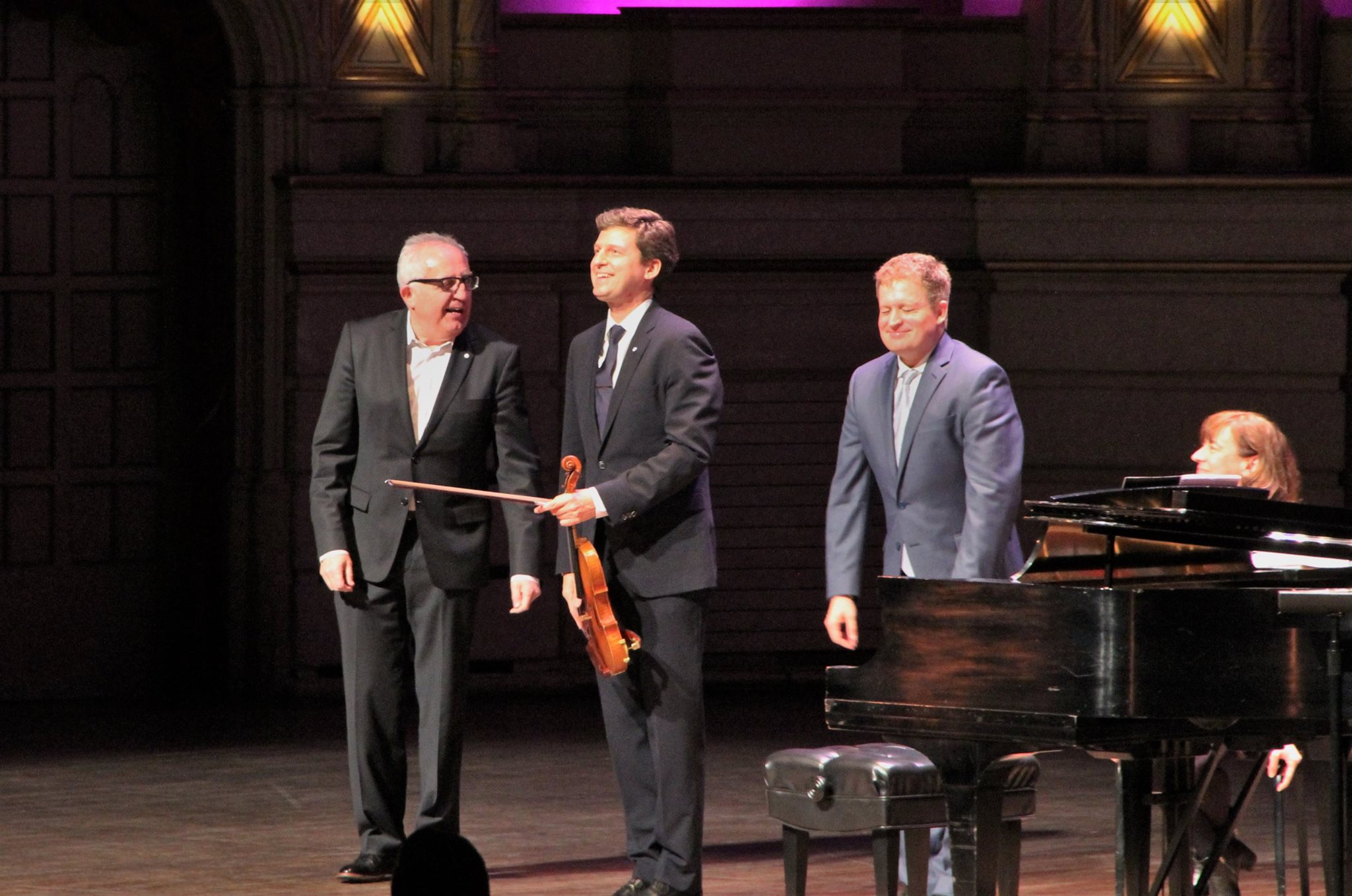VIOLINIST JAMES EHNES CELEBRATES HIS 40TH BIRTHDAY IN STYLE
James Ehnes, violin; Andrew Armstrong, piano: Works by Handel, Beethoven and Tovey, Orpheum, May 9, 2016.
Photos courtesy of Vancouver Symphony.
And the ‘stars’ keep coming! Less than a week ago, Bryn Terfel was here to give a recital as part of his 50th birthday celebration tour. Now violinist James Ehnes arrives to do the same thing as part of his 40th birthday tour, which extends to no less than 25 Canadian cities. While we are often inclined to think of the ‘art’ of both as timeless, it is humanizing to find that both performers take the passage of time seriously. James Ehnes has had a long association with Maestro Bramwell Tovey and the Vancouver Symphony. One of Ehnes’ breakthrough recordings (2006), featuring the Korngold, Barber, Walton concertos, was a collaboration with Tovey and the orchestra, and won both Juno and Grammy awards. Here the tie extended in a different direction, since Tovey – a composer in recent years – was asked to write a short violin piece for Ehnes’ celebration. Thus, we heard Tovey’s Stream of Limelight, just premiered in Ottawa ten days before this concert. It turned out to be quite engaging, and was played beautifully.
Ehnes was joined by pianist Andrew Armstrong, and my esteemed colleagues Claire Seymour (review) and Mark Berry (review) have been strongly positive on the duo’s Wigmore Hall recitals of modern works over the past year. Armstrong originally won the Jury Discretionary Award at the 1993 Van Cliburn Competition, and was the youngest pianist participating.
Handel and Beethoven contributed the violin sonatas of the first half. I am sure that Ehnes had no intention of being controversial by playing the former’s D major Sonata with piano, rather than harpsichord, but I admit that the performance took me back to the spirit of the less adorned and more padded style that was common in earlier days. In fact, the last Handel recordings I recall that employed piano accompaniment of the violin are those of Nathan Milstein and Artur Balsam, and David Oistrakh and Vladimir Yampolsky, around 1955. Even though the current performance was conspicuously free of Baroque style, I quite enjoyed it. It was beautifully-shaped by Ehnes at the beginning, with considerable lightness and agility in the subsequent Allegro. The Larghetto was highlighted by the violinist’s very pure playing, with long beautiful lines, though the absence of ornaments made it somewhat plain. The finale had a definite athleticism, with well-defined detail and accents. One expects the highest level of technical prowess from the violinist but Armstrong’s playing was very precise and attentive too, minimizing potential heaviness. My anachronistic thrill was hearing some of the same romantic, sentimental veneer in the slower passages as I did many years ago.
The opening movement of the Beethoven’s ‘Spring’ Sonata was well fashioned, long sailing lines from Ehnes in the opening motive, combining with strong dramatic accents elsewhere. Armstrong was fleet fingered and animated, but perhaps found less repose than one might wish. While there was warmth of feeling present, it seemed that the innocent joy of this movement did not stand out fully. This was somehow sleeker. The Adagio was presented with all the beauty that one might expect from a violinist of Ehnes’ stature, yet I wasn’t convinced that it was always the right type of beauty. At the beginning, the violinist’s tendency to introduce a gentle crescendo into each of his silken long phrases struck me as more studied than deeply felt. He was more on the mark later on, when the lovely key modulations occur, unearthing a true and natural radiance. After a rhythmically-precise Scherzo, the finale was a model of structural cogency, featuring intriguing innovations in phrasing from Ehnes, and particularly agile pianism from Armstrong. It finished with a robust energy. I found this an assured, elegant performance, warm and somewhat big-boned in feeling, but significantly less prone to the tender, striking revelations that one can find, say, in Isabelle Faust and Alexander Melnikov. Perhaps I might put it closer to Renaud Capucon and Frank Braley in its motion and beauty, with the caveat that Armstrong’s Beethoven style is a little on the eager side for my taste.
Bramwell Tovey’s Stream of Limelight is not a cutting, acerbic piece for violin that one often associates with modern constructions. Rather, it is essentially a lyrical piece that plays into the things that Ehnes does well. Starting from a tonal sequence vaguely reminiscent of a Bach Partita, it moves forward somewhat like a ‘turn of the century’ violin sonata. There is a hint of Bartok’s urgency and density, the rhapsodic fervour of Janacek, with the piano accompaniment sometimes in the spirit of Debussy. And, yes, one can find a touch of Elgarian whim too. However, it was all put together so artfully that it achieved its own voice without ever veering into the demonstrative or tonally threatening. Ehnes seized its lyrical flow and feeling perfectly, and I thought this was some of his most committed playing. There were a few transitional passages that worried me over the work’s 9 minutes: the dramatic chord sequence just before the end struck me as somewhat unsophisticated in construction, and there were a few other ‘gaps’ that stood out. Nonetheless, this seemed an appealing work with an often tender spirit, and I would urge other violinists to try it.
Nine minutes is distinctly short for a second half of a concert, so the remainder was filled out by the ‘James Ehnes Show’, starting from the Flight of the Bumble Bee, and essentially alternating between pieces that call for pyrotechnics and sentimental ‘salon’ pieces. Transcriptions by Kreisler and Heifetz of course figured among them, and the closing number was Sarasate’s dazzling Introduction and Tarantella. Enjoyable miniatures for the violinist’s strong following, if not the most substantial way to end a concert. But who can argue with a birthday boy!
© Geoffrey Newman 2016

